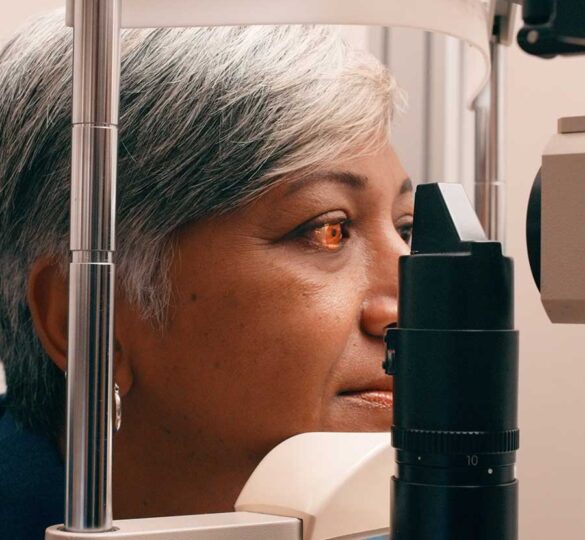The Importance of Regular Eye Exams to Detect Glaucoma
Regular eye exams are crucial for detecting glaucoma because most people with the condition don’t experience any symptoms until they’ve already suffered significant vision loss.

Eyesight is an incredibly precious gift that profoundly impacts our daily existence and connection with the world. It’s not just about being able to see; it’s about experiencing life to its fullest. Our eyes allow us to enjoy a vibrant sunset, read facial expressions, and navigate the world easily and confidently. Our vision makes simple joys possible, like reading books or admiring art. It also affects our safety and independence.
Unfortunately, the struggles associated with poor vision or vision loss are profound, affecting a person’s ability to perform daily tasks and limiting their social interactions and overall quality of life. It’s vital to prioritize our eye health and seek regular eye examinations to prevent any issue that could rob us of our cherished eyesight.
Glaucoma — often called the “silent thief of sight” because it usually shows no symptoms until significant vision loss has occurred — is a group of eye conditions that, if left untreated, can lead to irreversible vision loss. The damage is often caused by an abnormally high pressure in your eye.
There are different types of glaucoma, but the most common form in the US is primary open-angle glaucoma. It develops slowly and painlessly without any initial vision changes or other noticeable symptoms.
Why Are Regular Eye Exams Important?
Vision loss due to glaucoma cannot be restored. Regular eye exams are crucial for detecting glaucoma because most people with the condition don’t experience any symptoms until they’ve already suffered significant vision loss. According to the Centers for Disease Control and Prevention (CDC), 50% don’t know they have the disease. Regular eye exams are critical for the following reasons:
Early Detection
Early detection of glaucoma is vital for preventing vision loss. Eye doctors can check for signs of glaucoma before symptoms develop, allowing for early intervention and treatment. Treatment can slow down or stop the progression of the disease.
Monitoring
Regular eye exams also allow for ongoing monitoring of the disease. Glaucoma can progress over time, and treatment may need to be adjusted accordingly. Regular monitoring ensures the treatment remains effective and the condition does not worsen.
What Happens During an Eye Exam for Glaucoma?
A comprehensive eye examination involves several tests to measure pressure in your eyes, examine your optic nerve, and test your field of vision. These tests are typically quick, non-invasive, and painless. An eye exam can include:
Tonometry
Tonometry measures the pressure inside your eye. Elevated pressure is a significant risk factor for glaucoma.
Ophthalmoscopy
Ophthalmoscopy allows the eye doctor to examine the shape and color of the optic nerve. Changes in the appearance of the optic nerve may indicate damage caused by glaucoma.
Perimetry
Perimetry, or visual field testing, checks for areas of vision loss. Glaucoma often affects an individual’s mid-peripheral vision first, so this test is crucial for detecting early signs of the disease.
Gonioscopy
Gonioscopy checks the eye’s internal drainage system to ensure the drainage system is working correctly.
Pachymetry
Pachymetry is a simple test to measure the thickness of your cornea — the clear front surface of your eye. A thick cornea can lead to a false high-pressure reading, and a thin cornea can lead to a false low reading.
Who’s at Risk for Glaucoma?
Anyone can develop glaucoma; however, members of several demographics face a higher risk of developing glaucoma, including:
How Often to Get Your Eyes Examined
If you are younger than 40 and have no known risk factors for glaucoma, the American Academy of Ophthalmology (AAO) recommends a complete eye exam every 5 to 10 years. The exam includes tests that check for glaucoma.
The recommended schedule for those over 40 are:
- Every 1-2 years for adults 40-54
- Every 1-3 years for adults 55-64
- Every 1-2 years for adults 65+
- Every 1-2 years for African Americans 40+
People at higher risk may need exams more frequently. Ophthalmologists may recommend exams every six to twelve months for early detection if you have risk factors like high eye pressure or a family history of glaucoma.
Don’t delay your eye exam. Regular eye exams are easy and painless. They take just a few minutes but are essential to protect your vision from glaucoma damage. Don’t delay scheduling your next exam. Early glaucoma detection can prevent vision loss and ensure you keep seeing clearly for years. With early diagnosis, treatment, and careful monitoring, glaucoma can be treated successfully, preventing it from causing permanent and significant vision impairment.
Video: Understanding Glaucoma Diagnostic Exams
In this video, Dr. Danica J. Marrelli discusses the various diagnostic tests that your eye doctor uses to check for signs of glaucoma during a comprehensive eye examination.
Article reviewed for medical accuracy by Ruth Williams, MD. First posted on October 3, 2023. Last updated February 11, 2025.

Ruth Williams, MD
Ruth D. Williams, MD is a glaucoma specialist at the Wheaton Eye Clinic in Wheaton, Illinois. She is a past president of the American Academy of Ophthalmology and a national spokesperson on ophthalmic issues.